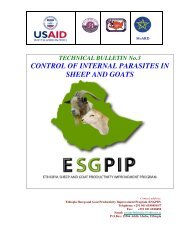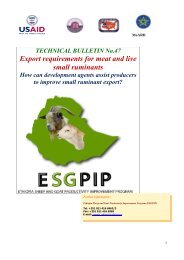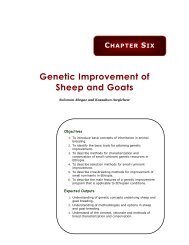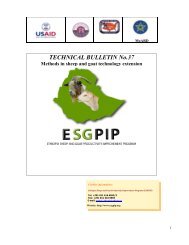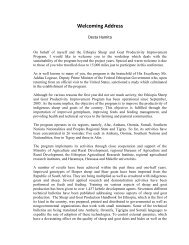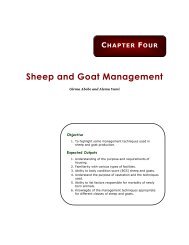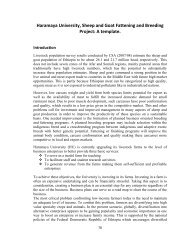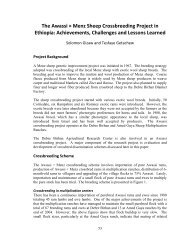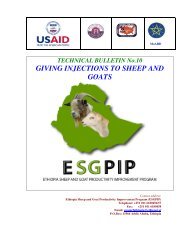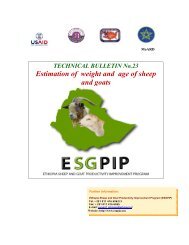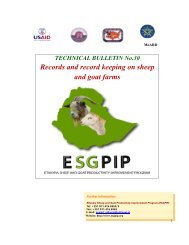BODY CONDITION SCORING OF SHEEP AND GOATS - esgpip
BODY CONDITION SCORING OF SHEEP AND GOATS - esgpip
BODY CONDITION SCORING OF SHEEP AND GOATS - esgpip
You also want an ePaper? Increase the reach of your titles
YUMPU automatically turns print PDFs into web optimized ePapers that Google loves.
MoARD<br />
TECHNICAL BULLETIN No.8<br />
<strong>BODY</strong> <strong>CONDITION</strong> <strong>SCORING</strong> <strong>OF</strong> <strong>SHEEP</strong><br />
<strong>AND</strong> <strong>GOATS</strong><br />
Contact address:<br />
Ethiopia Sheep and Goat Productivity Improvement Program (ESGPIP)<br />
Telephone: +251 011 6180456/57<br />
Fax: +251 011 6180458<br />
Email: pvamrfethiopia@ethionet.et<br />
P.O.Box: 15566 Addis Ababa, Ethiopia
FOREWORD<br />
This Technical Bulletin titled “Body condition scoring of sheep and goats” is the eighth<br />
in a series produced by the Ethiopia Sheep and Goat Productivity Improvement Program<br />
(ESGPIP). The ESGPIP is a USAID-funded Project with the objective of improving the<br />
productivity of Ethiopian sheep and goats.<br />
Body condition scoring is a very useful tool that guides breeding, selection, management<br />
and marketing decisions. The use of this tool helps producers evaluate the feeding of their<br />
animals, make reproductive and culling decisions, and evaluate animals when selling and<br />
buying. This is important to improve the efficiency of sheep and goat production and<br />
benefits of the producer.<br />
This Technical Bulletin is intended to serve as an extension aid for Kebele Development<br />
Agents (KDA’s) to help improve the productivity of sheep and goats through increasing<br />
producers’ knowledge regarding evaluation of body condition of sheep and goats. The<br />
information contained in this Technical Bulletin is also relevant to other users engaged in<br />
business ventures based on sheep and goat rearing and also production of other types of<br />
ruminants.<br />
At this juncture, I would like to thank all those involved in the preparation and review of<br />
this Technical Bulletin.<br />
Desta Hamito (Prof.)<br />
Chief of Party<br />
ESGPIP<br />
i
TABLE <strong>OF</strong> CONTENTS<br />
FOREWORD .................................................................................................................................................I<br />
TABLE <strong>OF</strong> CONTENTS ............................................................................................................................ II<br />
1. WHY <strong>BODY</strong> <strong>CONDITION</strong> SCORE ............................................................................................... 1<br />
2. WHEN TO <strong>BODY</strong> <strong>CONDITION</strong> SCORE ........................................................................................ 1<br />
3. HOW TO ASSIGN <strong>BODY</strong> <strong>CONDITION</strong> SCORE .......................................................................... 1<br />
3.1. LUMBAR REGION.......................................................................................................................... 1<br />
3.2. RIB CAGE ..................................................................................................................................... 3<br />
3.3. STERNUM..................................................................................................................................... 3<br />
4. CHANGES IN <strong>BODY</strong> <strong>CONDITION</strong> SCORE.................................................................................. 4<br />
5. SUMMARY ......................................................................................................................................... 6<br />
ii
<strong>BODY</strong> <strong>CONDITION</strong> <strong>SCORING</strong> <strong>OF</strong> <strong>SHEEP</strong> <strong>AND</strong> <strong>GOATS</strong><br />
Prepared By: Girma Abebe<br />
Edited by: Alemu Yami and R.C. Merkel<br />
1. Why Body Condition Score<br />
Body condition scoring (BCS) is a means of evaluating an animal based upon muscle and<br />
external fat cover. BCS is a simple, useful procedure that producers can use to make<br />
management decisions regarding the health of their animals and the quality and quantity of<br />
feed needed to optimize performance. If animals are in poor body condition, the animal may<br />
be underfed or have a disease problem. If animals are in too good of a body condition, the<br />
amount of feed can be decreased. Body condition will fluctuate during changes in feed<br />
supply. By evaluating animals, producers can prevent drastic losses in production.<br />
There are circumstances where body weight per se does not reflect an animal’s condition, i.e.,<br />
an animal with a large frame may have a higher body weight when at a low level of body<br />
reserves than another animal with a small frame but abundant reserves. Large variation in<br />
gross live weight may also occur because of changes in gut fill, pregnancy and parturition.<br />
The nutritional plane to which an animal has been exposed over a reasonable length of time is<br />
reflected by the extent to which fat is stored or muscle mass has been diminished. This may<br />
be assessed visually and expressed as a condition score.<br />
2. When to Body Condition Score<br />
Important times to condition score animals include pre-breeding, mid-gestation, early<br />
lactation, weaning, and before sale. Body condition at mating is important as animals in poor<br />
condition may have difficulty conceiving and have fewer offspring. If females are too thin at<br />
the midpoint of gestation they are more likely to have small, weak offspring with low<br />
survivability and produce less milk. Management should be altered to try and address the<br />
problem. If animals are poorly conditioned during early lactation, they will have low milk<br />
production and wean smaller animals. These dams will draw upon body reserves losing<br />
further condition. Females with low BCS at weaning will take longer to breed and have lower<br />
conception rates. This lengthens kidding/lambing interval and represents loss of production<br />
and potential profit. Producers should condition score animals prior to sale to strengthen their<br />
bartering position.<br />
3. How to assign Body Condition Score<br />
Scoring sheep and goats is done using a BCS ranging from 1.0 to 5.0, with 0.5 increments.<br />
An animal of BCS 1.0 is extremely thin with no fat reserves and a BCS of 5.0 is a very overconditioned<br />
(obese) animal. In most cases, healthy sheep and goats should have a BCS of 2.0<br />
to 3.5. A BCS below 2.0 indicates a management or health problem. A BCS of 4.5 or 5 is<br />
almost never observed under normal management conditions.<br />
To assign a BCS, one must touch and feel the animal. In sheep, the lumbar region is the<br />
principal site for BCS determination while in goats the rib cage and sternum also play a role.<br />
3.1. Lumbar region<br />
This area contains the loin muscle and is located immediately behind the last rib and before<br />
the hip bones. Scoring in this area is based on determining the amount of fat and muscle over<br />
and around the vertebrae. Lumbar vertebrae have two protrusions, the vertical protrusion<br />
1
called the spinous process and the two horizontal protrusions called the transverse process.<br />
You should run your hand over this area and try to grasp these processes with your fingertips<br />
and hand as shown in Figures 1 to 3. The degree of sharpness or roundness of the lumbar<br />
vertebrae is assessed and used to assign BCS.<br />
Although the principle of body condition scoring is similar for sheep and goats, it is important<br />
to note differences that exist between sheep and goats.<br />
• Compared to sheep, goats have much less subcutaneous fat cover over the loin region<br />
(most of the fat deposition in goats is internal around the intestines and kidneys).<br />
However, goats will deposit some subcutaneous fat behind the shoulders over the rib<br />
cage.<br />
• In fat-tailed or fat-rumped sheep breeds, the tail could serve as additional measure of<br />
body condition. In goats these do not exist<br />
• The sternum could be used as an additional area to assess condition in goats. This<br />
would be difficult in sheep that have a mane.<br />
The following process may be followed during scoring:<br />
• Feeling the spinous process:<br />
o Feel the spinous process in the center of the sheep/goat back behind the last<br />
rib and in front of the hip bone and try to rank the animal based on the<br />
answers you give to the following question. Are the tips sharp or rounded<br />
• Assessing the loin muscle<br />
o Feel the fullness of muscle and fat cover on either side of the spinous process<br />
(either side of the backbone) and determine if the ridge of the spine is above<br />
the level of the muscle. Is the loin muscle shallow, moderate or full<br />
• Feeling the transverse process<br />
o Feel for the tips of the transverse process. Is it sharp or smoothly rounded<br />
o How far will the tips of your finger go under the transverse process<br />
Figure 1. Spinous and transverse process. Figure 2. Spinous process. Figure 3. Transverse process.<br />
Illustrations used with permission from Body Condition Scores in Goats taken from the Meat Goat Production Handbook,<br />
Langston University, 2007.<br />
2
3.2. Rib cage<br />
The second area to assess, particularly in goats, is the rib cage and fat cover on the ribs and<br />
intercostal (between ribs) spaces. Touch this area and determine if you can feel each of the<br />
ribs.<br />
Figure 4. The rib area<br />
Illustrations used with permission from Body Condition Scores in<br />
Goats taken from the Meat Goat Production Handbook, Langston<br />
University, 2007.<br />
3.3. Sternum<br />
The sternum is the third part to assess. In goats it is an important area to assess. The fat cover<br />
over the sternum (breast bone) is based upon the amount of fat that can be pinched.<br />
Figure 5. The sternum area<br />
Illustrations and photos used with permission from Body Condition Scores in Goats taken from the Meat Goat<br />
Production Handbook, Langston University, 2007.<br />
With practice, evaluating the BCS of an animal will only take about 10-15 seconds. By<br />
adding BCS as a regular part of your management program, you can more effectively monitor<br />
your feeding and herd health program for a healthy and productive herd.<br />
3
Table 1. Scales for Body Condition Scoring<br />
Condition Score Lumbar region Rib cage Sternum<br />
Starving 0 Extremely emaciated and on the point of death.<br />
It is not possible to detect any muscle or fatty<br />
tissue between the skin and the bone.<br />
Skin is sunken<br />
between visible<br />
ribs.<br />
Very thin 1 The spinous processes are prominent and<br />
sharp. The transverse process are also sharp,<br />
the fingers pass easily under the ends, and it is<br />
possible to feel between each process. The eye<br />
muscle areas are shallow with no fat cover.<br />
Thin 2 The spinous processes feel prominent but<br />
smooth, and individual processes can be felt<br />
only as fine corrugations. The transverse<br />
processes are smooth and rounded, and it is<br />
possible to pass the fingers under the ends with<br />
a little pressure. The eye muscle areas are of<br />
moderate depth, but have little fat cover.<br />
Moderate 3 The spinous processes are detected only as<br />
small elevations; they are smooth and rounded<br />
and individual bones can be felt only with<br />
pressure. The transverse processes are smooth<br />
and well covered, and firm pressure is required<br />
to feel over the ends. The eye muscle areas are<br />
full, and have a moderate degree of fat cover.<br />
Fat 4 The spinous processes can just be detected with<br />
pressure as a hard line between the fat covered<br />
eye muscle areas. The ends of the transverse<br />
processes cannot be felt. The eye muscle areas<br />
are full, and have a thick covering of fat.<br />
Very fat 5 The spinous processes can't be detected even<br />
with firm pressure, and there is a depression<br />
between the layers of fat in the position where<br />
the spinous processes would normally be felt.<br />
The transverse processes cannot be detected.<br />
The eye muscle areas are very full with thick fat<br />
cover. There may be large deposits of fat over<br />
the rump and tail.<br />
4. Changes in Body Condition Score<br />
Ribs are clearly<br />
visible.<br />
Some ribs can be<br />
seen. There is a<br />
small amount of fat<br />
cover. Ribs are<br />
still felt.<br />
Ribs are barely<br />
seen; an even<br />
layer of fat covers<br />
them. Spaces<br />
between ribs are<br />
felt using pressure.<br />
Ribs are not seen.<br />
Ribs are not visible<br />
and are covered<br />
with excessive fat.<br />
It is also important to note that BCS could vary according to the physiological status of the<br />
animal. An example which shows such a change is depicted below for ewes (Fig.6). At the<br />
time of mating does/ewes should have a score of 3 for optimum result with a range of 2 to 3<br />
being acceptable. Pregnant females need to be watched closely to make sure they are close to<br />
a score of 3 throughout this period.<br />
After the lambs/ kids are born and during lactation, it is normal for condition scores in<br />
ewes/does to reduce. However, make sure they do not drop from a score of 3 to a 2 or 1 too<br />
quickly. Lactation is demanding in terms of nutrient requirements. If lactating animals are not<br />
fed properly during this period, body reserves could be mobilized resulting in poor body<br />
condition. Lack of attention during this period will impact the growth of the nursing lamb/kid<br />
and milk yield.<br />
There is no sternal<br />
fat.<br />
Sternal fat is easily<br />
grasped and<br />
moved from side to<br />
side.<br />
Sternal fat is wider<br />
and thicker but can<br />
still be grasped<br />
and moved slightly<br />
from side to side.<br />
Sternal fat is wide<br />
and thick. It can<br />
still be grasped but<br />
has very little<br />
movement.<br />
Sternal fat is<br />
difficult to grasp<br />
and cannot be<br />
moved from side to<br />
side.<br />
Sternal fat extends<br />
and covers the<br />
sternum. It cannot<br />
be grasped<br />
4
Figure 6. Expected BCS changes throughout a ewe’s production cycle.<br />
Under ideal conditions, ewes/does should never be allowed to go below a BCS of 2. The same<br />
is true of the higher end of the scale. Ewes/does should not reach the BCS of 4 and should<br />
never reach a BCS of 5. Ewes/does with the high scores often do not breed, and if they do<br />
they may have difficulties.<br />
Ewes/does can increase in body mass, even in early lactation with adequate, good quality<br />
feed. However, in most cases, there is a decrease in body mass in early lactation when milk<br />
production is high and an increase in body mass in later lactation with declining milk<br />
production.<br />
One practical use of body condition score is in adjusting supplementary feeding up or down.<br />
BCS 1 BCS 2<br />
BCS 3 BCS 4 BCS 5<br />
Figure 7. Examples of spinous process in BCS of goats.<br />
Photos used with permission from the Meat Goat Production Handbook, Langston University, 2007.<br />
5
BCS 1 BCS 2<br />
BCS 3 BCS 4 BCS 5<br />
Figure 8. Examples of transverse process in BCS of goats.<br />
Photos used with permission from Body Condition Scores in Goats taken from the Meat Goat Production Handbook, Langston University,<br />
2007.<br />
BCS 1 BCS 2<br />
BCS 3 BCS 4 BCS 5<br />
Figure 9. Examples of sternal fat in BCS of goats.<br />
Photos used with permission from the Meat Goat Production Handbook, Langston University, 2007.<br />
5. Summary<br />
Body condition scoring is a useful procedure for routine decision making on the<br />
management of sheep and goats. Producers can use the technique to improve the<br />
profitability of their sheep and goat farms. Body condition scoring is a simple<br />
procedure of evaluating different parts of the animal and giving scores. Perfection in<br />
body condition scoring comes with experience and practice.<br />
6



